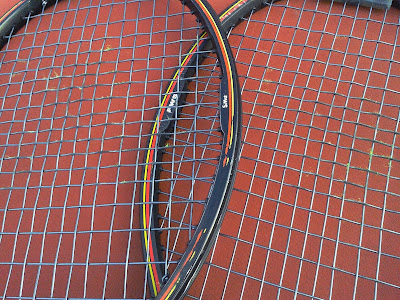It does not matter whether one can handle that racket. It must be owned and played with, before one can move on in their tennis pilgrimage.
During one's ownership of the "Staff", it must be tweaked, customised, strung and re-strung many times with plenty of lead tape liberally added, before one can be deemed to have attained nirvana. Anything less would be considered sacrilegious and possibly incur the wrath of St. Vincent!
Here I am, completing my rite of passage with a Taiwan-made (TW) and early China-made (CN) version.
Here's the TW version.
Here's the China version.
Being from different manufacturers, naturally the specs differ. Overall, the TW is a few grams lighter. Both swingweights are very close although balance is different.
Playtest:
- Even without any lead tape, sweetspot contacts are sweet!
- Off-center hits conveyed almost zero vibrations to the arm. The racket absorbed it all.
- Even when I hit a ball on the frame, it still felt less harsh than many modern rackets! It was almost comfortable to do that!
- Perhaps I am used to heavy rackets, but both of these played a little too light. My partner and I felt the strong and heavy plowthrough was lacking.
- In the absence of lead tape, I moved the 5g dampener around and it felt much better at 12 o'clock for both rackets. I'll add some lead later.
- Needless to say, directional control and accuracy reigns supreme. Not even my PSC6.1 strung with Kevlar can surpass these! And neither of these two sticks felt stiff at all.
- Pocketing is good. Spin is excellent!
- Despite online comments about the differences between the TW and CN rackets, I felt both played very very close. Usually, any differences would surface during or after some customisation. I'll keep a lookout for that.
The mystery about my vintage Wilson XT-80 headsize is finally solved!!! It's 80 sq inches!!! You can see it's slightly smaller than both ProStaff 6.0s.
Ball fur pics below
03Apr2013 update:
- To accelerate the search for my preferred balance, I leaded up both rackets to match the lightest and heaviest setups that I think I can tolerate. I'll then adjust inwards and hopefully, they'll converge somewhere.
- The lighter stick moved fast but lacked plowthrough for serves and volleys.
- Against heavy flat shots, I had to be very precise or the frame would twist. The heavy racket is incredibly stable and a light tap sends the ball deep into the baseline.
- Pocketing is shallow with the light racket and there is more shock and vibration compared to the heavy one.
- Control and accuracy is much better with the heavy racket even though I am slower with it. So while I could get to return more difficult shots with the light racket, I had to be more conservative in placement, which set me up for more trouble later.
- Overall, I would give higher marks for plowthrough, accuracy, spin, pocketing, comfort and power to the heavier stick.
- I'll bring down the weight a little for the next session...
10Apr2013 update:
- Differences between the two rackets are becoming apparent.
- The TW is more flexible while the CN is stiffer.
- The TW is more head heavy than the CN.
- With early preparation, both sticks are very powerful, accurate and generates heaps of spin.
- Ball fur pic below. The darker coloured strings area marks the sweet spot as well.
- Another one bites the dust...
Strings:
Pro Supex Synthetic Gut Titan 1.25mm @ 30 lbs (one-piece)












I am glad I found your blog. I have been thinking about getting a prostaff 85 from TW. For some reason I play better with a smaller racket frame, and in top of that I am an old school player. I prefer a small flexible frame with little power. But wow.. you string it up at only 30 lbs??
ReplyDelete